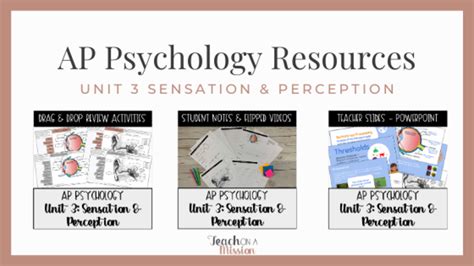Introduction

AP Psychology Unit 3 delves into the fascinating world of sensation and perception, exploring the mechanisms by which our senses gather information from the environment and our brains interpret it. This unit lays the foundation for understanding the complex processes that shape our experiences and guide our behavior.
Sensation
- Definition: Sensation is the process by which sensory organs convert physical stimuli into neural signals.
- Types of Sensory Receptors: Our bodies have specialized sensory receptors that respond to specific types of stimuli, including mechanoreceptors (touch), thermoreceptors (temperature), photoreceptors (light), chemoreceptors (taste and smell), and proprioceptors (body position).
- Sensory Thresholds: The minimum intensity of a stimulus that can be detected is called the absolute threshold. The difference between the absolute threshold and the level at which a stimulus is consciously perceived is known as the difference threshold.
Perception
- Definition: Perception is the process by which our brains organize and interpret sensory information to create a meaningful representation of the world.
- Top-Down and Bottom-Up Processing: Perception involves both bottom-up processing (sensory information processed in a hierarchical fashion) and top-down processing (influenced by our expectations, beliefs, and experiences).
- Perceptual Illusions: Perceptual illusions occur when the brain misinterprets sensory information, leading to distortions in our perception.
Vision
- Structure of the Eye: The eye is a complex organ consisting of the lens, retina, optic nerve, and various other structures that work together to convert light into neural signals.
- Visual Acuity: Visual acuity refers to the clarity of vision, which is measured using an eye chart.
- Color Vision: Color vision is possible due to photoreceptor cells in the retina that are sensitive to different wavelengths of light.
Hearing
- Structure of the Ear: The ear consists of the outer, middle, and inner ear, each with specific functions in transmitting sound vibrations.
- Auditory Thresholds: Like vision, the ear has absolute and difference thresholds for sound.
- Loudness and Pitch: The loudness of a sound is determined by its amplitude, while its pitch is determined by its frequency.
Other Senses
- Taste and Smell: Taste and smell sensations are mediated by chemoreceptors in the mouth and nose, respectively.
- Touch: The skin contains several types of mechanoreceptors that respond to various forms of touch, including pressure, temperature, and vibration.
- Vestibular and Proprioception: The vestibular system in the inner ear provides information about head position and movement, while proprioceptors in muscles and joints sense body position.
Applications of Sensation and Perception Research
- Medical Diagnosis: Understanding sensation and perception allows doctors to identify and diagnose sensory disorders, such as hearing loss or color blindness.
- Sensory Marketing: Businesses use sensory marketing techniques to create appealing products and experiences that stimulate consumers’ senses.
- Human Factors Engineering: The principles of sensation and perception are applied in the design of safe and efficient work environments.
Tables
| Sensory Receptor | Stimulus |
|---|---|
| Mechanoreceptors | Touch |
| Thermoreceptors | Temperature |
| Photoreceptors | Light |
| Chemoreceptors | Taste and smell |
| Proprioceptors | Body position |
| Perceptual Illusion | Description |
|---|---|
| Müller-Lyer Illusion | Lines of equal length appear different due to converging or diverging lines |
| Ponzo Illusion | Horizontal lines appear different lengths due to the angle of converging lines |
| Ames Room Illusion | A room appears either larger or smaller than it actually is due to the distortion of its shape |
| Ebbinghaus Illusion | A central circle appears larger or smaller depending on the size of surrounding circles |
| Pros of Top-Down Processing | Cons of Top-Down Processing |
|---|---|
| Incorporates prior knowledge and experience | Can lead to perceptual biases |
| Provides context and meaning to sensory information | Can interfere with objective perception |
| Enhances the speed of perception | Can result in misinterpretations |
FAQs
- What is the difference between sensation and perception? Sensation is the conversion of physical stimuli into neural signals, while perception is the interpretation of those signals to create a meaningful representation of the world.
- Why do we experience perceptual illusions? Perceptual illusions occur when the brain misinterprets sensory information due to cognitive biases or limitations in the sensory system.
- How does culture influence perception? Culture can shape our perception of colors, shapes, and even emotions.
- Can we improve our sensory abilities? Some studies suggest that it is possible to improve sensory acuity through practice and training.
- How is sensation and perception used in everyday life? We rely on sensation and perception to navigate our environment, interact with others, and make decisions.
- What are some applications of sensation and perception research? Sensation and perception research has applications in medicine, marketing, and human factors engineering.
Conclusion
AP Psychology Unit 3 provides a comprehensive overview of the fascinating and complex processes of sensation and perception. By understanding these processes, we gain a deeper appreciation of how we experience and interpret the world around us. This knowledge not only enhances our understanding of human behavior but also has practical applications in various fields.
